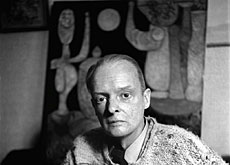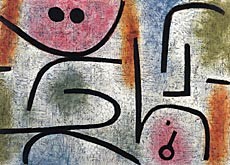A sentimental journey through the life of Klee

To mark the 125th anniversary of the birth of Paul Klee, Bern’s Kunstmuseum is offering glimpses of the artist through a very personal looking glass.
The “Musée Sentimentale” is an exhibition of memorabilia that guides visitors through the various stages of his life.
The first stop is Klee’s childhood, captured in black and white photographs of the artist as a young boy.
Housed in a coin-sized white box is a lock of his mid-blond hair, preserved by elder sister, Mathilde. Displayed next to it is one of the artist’s baby shoes, wrinkled with time.
Staying with the young Klee, visitors can read school reports and see a photograph taken in 1898 during a school outing.
All the boys in the sepia picture are wearing boater hats. Klee’s seems to be placed on his head at a jauntier angle than the others.
The exhibition came about after the Paul Klee Foundation issued an appeal in the local papers in Bern earlier this year, asking people to come forward with any objects they might have, with a connection to the artist.
The quality of the end result is impressive, although quantity is lacking. Time proved to be the greatest enemy – too much had passed and many of those whose lives had crossed paths with Klee’s were no longer around.
The more private effects are on loan from Klee’s family.
Bern man
The artist spent a total of 33 years, more than half his lifetime, in and around canton Bern.
He was born in Münchenbuchsee on December 18, 1879, to a German father and a Swiss mother, and later moved as a child to Bern, where he completed his schooling.
Even though he travelled to Italy, Tunisia and Egypt, and spent 20-odd years living in Germany, he was a regular visitor to the Swiss capital.
Klee resettled in Bern in 1933 after losing his job at the Düsseldorf Academy of Fine Arts in Germany, where he was branded a degenerate artist by the Nazis.
He spent his last years in the Swiss capital, living for the most part in a flat at Kistlerweg 6 in the Elfenau area of Bern. He died on June 29, 1940, in Muralto, Switzerland.
Throughout his lifetime, Klee was considered to be a trendsetter among the modern artists of the 20th century.
He became famous for his abstract landscapes or “mindscapes”, with his later works characterised by bold strokes against colourful backgrounds.
Still life
The press appeal unearthed a previously unknown still life, a study of flowers in a vase. Klee had given this small picture, which he painted in around 1908, to his sister.
She, in turn, gave it in 1930 to a friend, with whom she drank tea regularly.
It is chocolate-box pretty and quite unlike the bold, abstract motifs for which Klee is famous.
Visitors can see a middle-sized leather suitcase, which is dark-coloured with a light-brown trim. This accompanied Klee on his travels to Egypt in 1928 and bears a sticker from the Luxor hotel in which the artist stayed.
There is also a grey-coloured wigmaker’s dummy. It has wide eyes painted on it in a style typical of Klee.
While it certainly belonged to the artist, there are no photographs showing where he might have stored it.
The exhibition also contains a small African figure carved from wood; behind it is an enlarged photo of Klee’s Weimar studio, showing the figure in its original location.
An assortment of key rings for the flat in Kistlerweg are also on display, each bearing a tag written by Klee.
Abbreviations in spidery handwriting denote which room they belonged to, such as “Schlafz” for “Schlafzimmer” or bedroom or “Tür” for front door.
As well as the artist’s pipes, there are also sketchbooks belonging to his first art student. They are open at the pages where she sketched her teacher.
Hand-me-down
Then there is a black and white photo of Klee in 1940, the year of his death, sitting in a room in the Kistlerweg flat.
His skin is drawn tight over sunken cheeks, and he’s wearing a light-coloured, hand-knitted jumper.
The photo is tacked onto a glass display box containing an oatmeal-coloured jumper small enough for a six-year-old child.
Next to his picture is another one with the chirpy face of a dark-haired boy, wearing the same small jumper.
All three pullovers are one and the same: Klee wore it in 1940; a few years after his death, his daughter-in-law reworked it for her small son, Alexander.
The exhibition runs until the end of December.
swissinfo, Faryal Mirza
Artist Paul Klee was born on December 18, 1879, in Münchenbuchsee, canton Bern.
He spent 33 years of his life in and around Bern.
He moved back to Bern in 1933 from Germany, after being hounded by the Nazis.
He died on June 29, 1940, in Muralto, Switzerland.
Bern’s Kunstmuseum is hosting the “Musée Sentimentale” exhibition until the end of December.
It contains a number of personal effects belonging to Paul Klee, as well as other objects connected to the artist unearthed by local people from Bern.

In compliance with the JTI standards
More: SWI swissinfo.ch certified by the Journalism Trust Initiative










You can find an overview of ongoing debates with our journalists here . Please join us!
If you want to start a conversation about a topic raised in this article or want to report factual errors, email us at english@swissinfo.ch.